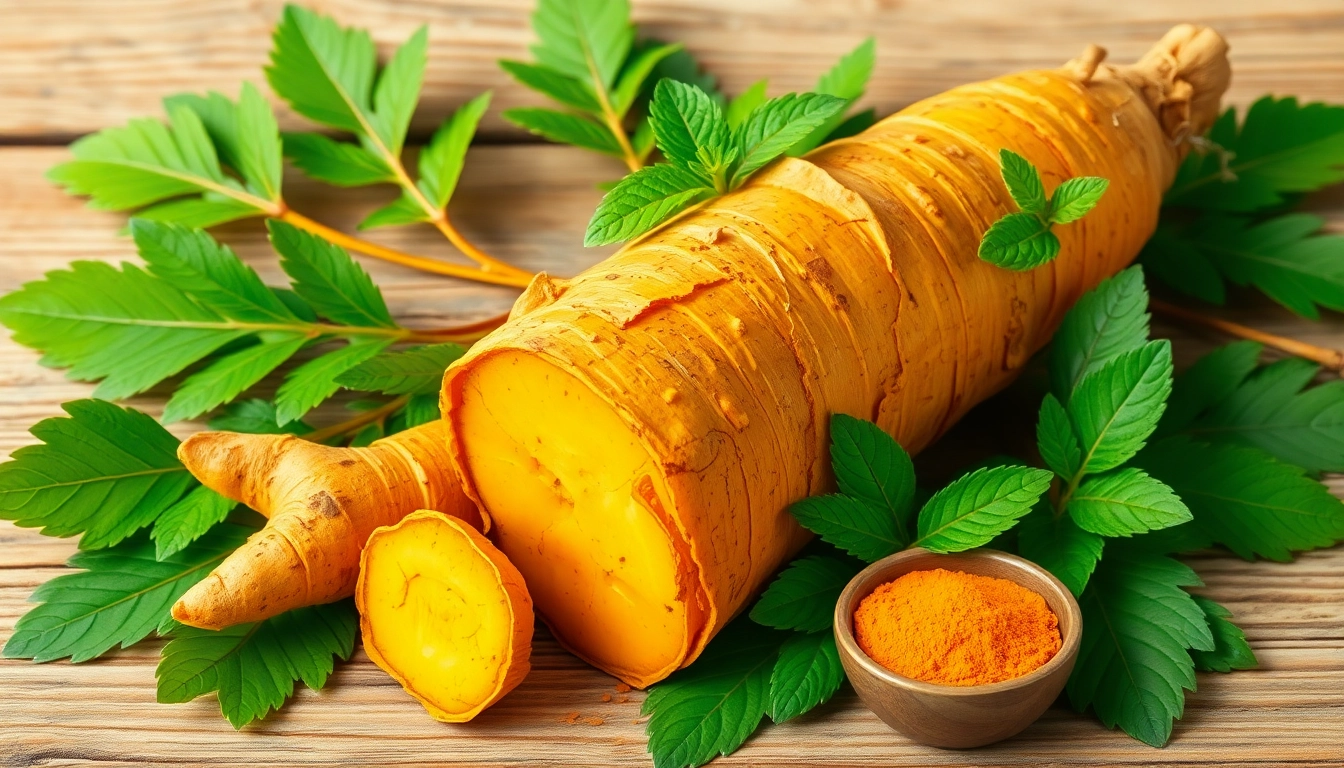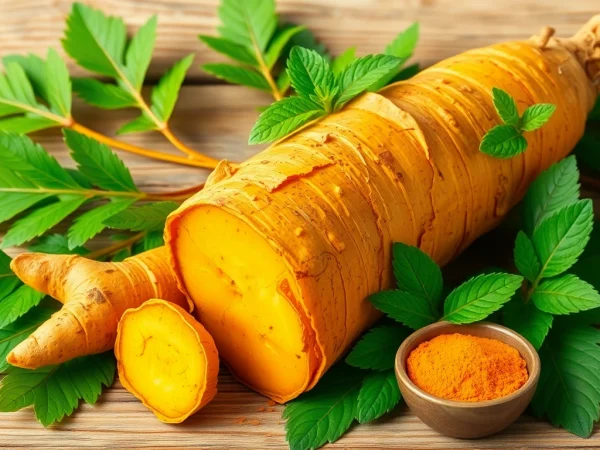The Health Benefits of Turmeric Root: Nature’s Golden Rhizome
Understanding Turmeric Root
What is Turmeric Root?
Turmeric root, scientifically known as Curcuma longa, is a rhizome belonging to the ginger family, originating from Southeast Asia. This vibrant yellow-orange root has been a cornerstone of culinary traditions and medicinal practices in various cultures for centuries. Primarily recognized for its potent active compound, curcumin, turmeric is celebrated not only as a spice but also for its numerous health benefits.
The turmeric plant thrives in tropical climates, often found in moist, rich soils. The root itself is harvested after about 8-10 months of growth, making it a labor-intensive process. Once harvested, the rhizomes are typically boiled, dried, and ground into a fine powder, although fresh turmeric root can also be utilized in cooking and health applications. This plant is not just a spice but a vital part of traditional medicine, particularly Ayurveda and Traditional Chinese Medicine, where it has been used for thousands of years. For those looking to incorporate turmeric into their diet, turmeric root is available in various forms, each offering unique benefits.
The Nutritional Profile of Turmeric Root
Understanding the nutritional profile of turmeric root can highlight its myriad health benefits. Fresh turmeric root contains essential vitamins and minerals such as Vitamin C, Vitamin E, Vitamin K, and various B vitamins. It also provides an array of important minerals, including potassium, magnesium, and iron.
Perhaps the most notable aspect of turmeric’s nutritional profile is its high concentration of curcumin, which contributes to most of its health claims. Additionally, turmeric contains various other bioactive compounds that contribute to its anti-inflammatory and antioxidant properties. The following table summarizes some key nutritional components of turmeric root:
| Nutrient | Amount per 100g |
|---|---|
| Calories | 354 |
| Carbohydrates | 65 g |
| Protein | 7.8 g |
| Fat | 9.9 g |
| Fiber | 22 g |
| Curcumin | 3% – 5% of the root |
Incorporating turmeric into your diet can enhance overall health and contribute to nutritional adequacy, making it a worthy addition to various cuisines.
Historical Uses and Cultural Significance
Historically, turmeric has been revered as a sacred plant in many cultures, particularly in India, where it holds a significant place in Hindu rituals and Ayurvedic medicine. Its vibrant color and purported health benefits earned it the nickname “golden spice.” In traditional practices, turmeric has been used not only as a cooking ingredient but also for its healing properties to treat various ailments such as digestive issues, skin conditions, and inflammatory diseases.
In China, turmeric has been utilized for its medicinal properties, documented since the 7th century. Traditional Chinese Medicine incorporates turmeric for its warm nature, believed to help with blood circulation and to alleviate joint pain. Furthermore, in Southeast Asian cuisines, turmeric is a fundamental ingredient in curry powders and is known for its ability to enhance flavor and color in dishes.
Health Benefits of Turmeric Root
Anti-Inflammatory Properties of Turmeric Root
One of the most significant health benefits attributed to turmeric root is its potent anti-inflammatory properties. Chronic inflammation is increasingly recognized as a contributor to various diseases, including heart disease, cancer, and neurodegenerative conditions. Curcumin, the active compound in turmeric, has been shown in numerous studies to inhibit the activity of pro-inflammatory molecules such as cytokines and enzymes.
Research has indicated that individuals who incorporate turmeric into their diet may experience a reduction in symptoms associated with inflammatory conditions, including arthritis and joint pain. A study published in the Journal of Alternative and Complementary Medicine highlighted that participants who took curcumin supplements reported significant improvements in joint pain compared to those taking a placebo.
Potential Antioxidant Effects
Antioxidants play a crucial role in defending the body against oxidative stress, which can lead to cellular damage and various chronic diseases. Curcumin is recognized for its ability to neutralize free radicals due to its chemical structure. This potent antioxidant action may help to protect against conditions such as cancer and heart disease.
A review in the journal Frontiers in Pharmacology presented evidence that curcumin not only acts as an antioxidant but may also enhance the activity of the body’s own antioxidant enzymes, offering a dual mechanism of defense against oxidative damage.
Turmeric Root in Traditional Medicine
In addition to its anti-inflammatory and antioxidant properties, turmeric root has been a staple in traditional medicine around the globe. Ayurvedic practitioners have utilized it for centuries to improve digestion, support skin health, and promote overall wellness. Turmeric’s use in treating digestive disorders, such as bloating and gas, is well-documented, with many suggesting it stimulates bile production, which aids in fat digestion.
Equally important is its role in skin care, where turmeric is applied to combat conditions like acne and eczema. Its natural antibacterial and anti-inflammatory properties make it beneficial in promoting clearer skin and healing wounds. A study published in the International Journal of Dermatology confirmed that topical turmeric treatment significantly reduced the severity of acne when compared to standard treatments.
How to Use Turmeric Root
Culinary Applications of Turmeric Root
Turmeric root can be used in a variety of culinary applications, adding both flavor and health benefits to dishes. Fresh turmeric can be grated and added to curries, soups, and stews for a rich, earthy flavor. It may also be incorporated into smoothies for a vibrant color and nutritional boost.
When using dried turmeric powder, consider incorporating it into marinades, salad dressings, or as a seasoning for roasted vegetables. The warm, slightly bitter flavor pairs well with spices like cumin and coriander, enhancing the depth of various dishes.
For tea, simmer fresh turmeric root in water with ginger and a squeeze of lemon for a soothing drink that harnesses turmeric’s health benefits. Additionally, turmeric lattes, popularly known as “golden milk,” mix turmeric with milk or milk alternatives, spices, and sweeteners for a comforting beverage.
Preparation Methods for Optimal Benefits
To maximize the benefits of turmeric root, consider specific preparation methods that enhance its absorption and bioavailability. Curcumin is not easily absorbed by the body; therefore, pairing turmeric with black pepper, which contains piperine, can significantly increase its absorption by up to 2000%.
Another effective method is to consume turmeric with healthy fats, such as olive oil or coconut oil, which can help dissolve curcumin, making it more available for absorption. Cooking turmeric in oil or fat can further enhance the bioavailability of its beneficial compounds.
Incorporating Turmeric Root into Your Diet
Incorporating turmeric root into your diet can yield numerous health benefits. Start with small amounts, gradually increasing as tolerated. Consider using turmeric in your daily routines; for instance, add a teaspoon of grated fresh turmeric to your morning smoothie or oatmeal.
For those who find the taste of turmeric strong, try mixing it into more flavorful dishes that can mask its intensity. Experiment with different recipes that combine turmeric with herbs and spices you enjoy, ensuring you reap its benefits without overwhelming your palate.
Turmeric Root vs. Turmeric Powder
Comparative Nutritional Benefits
When comparing turmeric root to its powdered form, nutritional differences arise primarily in concentration and flavor. Fresh turmeric root offers higher moisture content and a more robust flavor than dried turmeric powder. While dried turmeric is convenient for long-term storage and use, fresh turmeric generally retains higher levels of beneficial compounds, including curcumin.
This distinction is critical when considering culinary and health applications; if the goal is to maximize taste and nutritional intake, utilizing fresh turmeric root may be preferable. However, for everyday practicality and ease of use, turmeric powder serves as a beneficial alternative still rich in curcumin.
Advantages of Fresh Turmeric Root
Fresh turmeric root has several advantages over powdered forms. Firstly, it often contains more potent concentrations of curcumin and other essential oils, which may be lost during the drying process. Furthermore, using fresh turmeric provides a vibrant flavor and aesthetic appeal to dishes, enhancing both nutritional value and culinary experience.
Fresh turmeric is versatile, allowing it to be used in making fresh juice, tea, or even as an ingredient in baked goods, thus opening up a variety of healthful culinary avenues.
Choosing the Right Form for You
Deciding between fresh turmeric root and turmeric powder may depend on personal preferences and specific health goals. If easy incorporation into daily meals is your priority, powdered turmeric is widely available and convenient. For maximum health benefits, including its bright flavor and moisture content, fresh turmeric root is best.
Regardless of the form chosen, both fresh and dried turmeric can contribute significantly to improved health, making them valuable dietary additions.
Where to Buy Quality Turmeric Root
Identifying Fresh Turmeric Root
When shopping for fresh turmeric root, look for firm, smooth skin without any signs of mold or shriveling. Fresh turmeric should have a vibrant color, ranging from deep orange to yellow, and should be aromatic. Consider purchasing from local markets or health food stores that specialize in organic produce to ensure quality and freshness.
In some cases, you may find fresh turmeric at specialty Asian grocery stores where it is commonly sold alongside other root vegetables. Ask staff for guidance if unsure about freshness to ensure optimal health benefits.
Buying Organic Turmeric Root Online
For those who prefer the convenience of online shopping, many retailers offer organic turmeric root. When purchasing online, check for reputable sources that provide product details, including origin, shipping conditions, and expiration dates. Customer reviews can also provide insights about the quality of the turmeric being offered. Websites specializing in organic foods or health supplements often carry high-quality turmeric options.
Storage Tips for Long-lasting Freshness
To preserve the longevity and flavor of fresh turmeric root, proper storage is essential. Store unpeeled turmeric in a paper towel in the refrigerator’s crisper drawer, where it can last up to two weeks. If you have peeled or cut turmeric, wrap it tightly in plastic wrap or store it in an airtight container to prevent moisture loss and contamination.
For long-term storage, consider freezing fresh turmeric. Peel and cut the root into manageable pieces before placing it in a tight-sealing container or freezer bag. This approach can extend its shelf life by several months, making it accessible for future culinary use.




